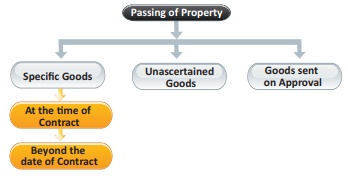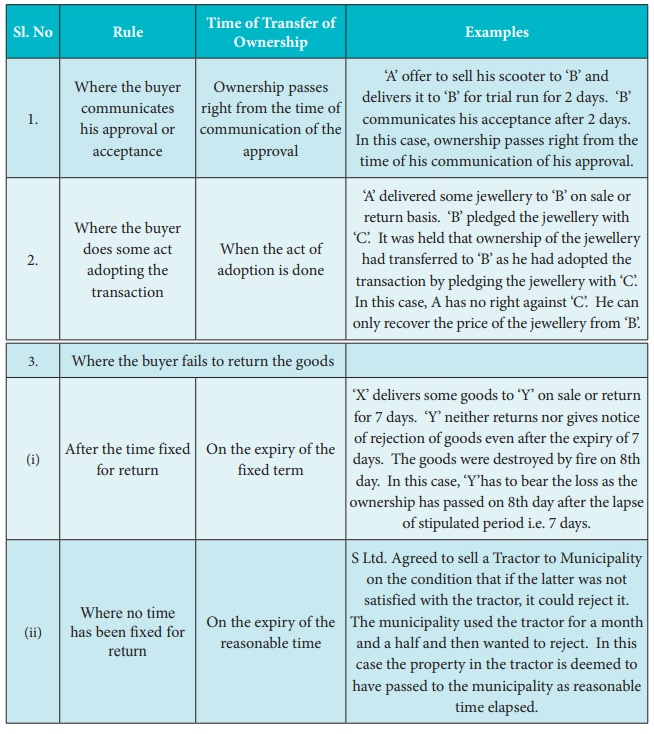The Sale of Goods Act 1930 - Transfer of Ownership | 12th Commerce : Chapter 21 : The Sale of Goods Act 1930
Chapter: 12th Commerce : Chapter 21 : The Sale of Goods Act 1930
Transfer of Ownership
Transfer of Ownership

Transfer of property (ownership) in goods from the
seller to the buyer is the main object of a contract of sale. The term property
in goods must be distinguished from possession of goods. Property in goods
means the ownership of goods while possession of goods refers to the custody of
goods or control over the goods.
For eg. ‘A’ may possess a watch. Just because ‘A’
possesses the watch, he cannot be owner. He might have borrowed the watch from
his friend or stolen the watch from somebody or found it on the highways. In
this case, he cannot be called owner. It is important to know the precise
movement of time at which the ownership in goods passes from seller to buyer.
Passing of Property
Transfer of title of a property is called as
passing of property.

I. Specific Goods
(i) At the Time of Contract
Where there is an unconditional contract for the
sale of specific goods in a deliverable state, ownership in the goods passes to
the buyer when the contract is made. The time of payment of price or time of delivery
of goods is immaterial in the matter of transferring the ownership of the
goods.
eg. ‘B’ selects certain books in a bookshop. The
price is settled. ‘B’ arranges to take delivery of books next day through his
servant and agrees to pay for the books on the 1st of next month. The books
were destroyed by fire in the same evening. In this case, ‘B’ has to bear the
loss and pay for the books selected since the ownership has already passed on
to ‘B’.
(ii) Beyond the Date of Contract
(a) Goods not in a Deliverable condition
Where there is a contract for sale of specific
goods not in a deliverable condition i.e. the seller has to do certain
activities to bring the goods into deliverable condition like painting, quality
checking, weighing etc., then the ownership does not pass till such activities
bringing them into deliverable condition are completed. eg. There was a
contract for a sale of machine weighing 30 tonnes and installed in a concrete
floor. Some parts of the machine were damaged during the process of removal. In
this case, buyer is entitled to refuse to buy the machine as it is not in a
deliverable condition.
(b) When the Price of Goods is to be Ascertained by Weighing or Testing or Doing Something
Where there is a contract for the sale of specific
goods in a deliverable condition, but the seller is yet to weigh, measure, test
or do some other act or think with reference to the goods for the purpose of
fixing the price, then the ownership in the goods passes to the buyer only
after such activities are carried out and completed and the buyer has a
knowledge of it.
eg. ‘A’ sold some quantity of wheat to ‘B’ at the
rate of Rs. 10 per kg. However, ‘A’ had to weigh the wheat in order to know the
price of the entire quantity of wheat sold to ‘B’. In this case, the ownership
of the wheat shall transfer to ‘B’ as soon as ‘A’ weighs the wheat ‘B’ comes to
know about the completion of the weighing activity.
II. Unascertained Goods
As already we studied that the unascertained goods
are those which are not specifically identified at the time of contract of
sale. The ownership in the case of unascertained goods, is transferred to the
buyer subject to the fulfilment of following conditions:
a. When the Goods are Ascertained
Ascertainment is a process by which the goods to be
delivered under the contract of sale are identified and set apart. It is a
unilateral act of the seller alone to identify and isolate the goods.
b. When the Goods are Appropriated to the Contract
Appropriation is a process by which the goods to be
delivered under the contract of sale are identified and isolated with the
consent of the seller as well as the buyer. It is a bilateral act of the seller
and the buyer to identify and isolate the goods. In other words, where the
goods identified and isolated are put into boxes or any container with the
consent of the buyer, it is called appropriation. eg. ‘A’ agrees to sell ‘B’
the oil to be produced by him. The oil was filled by ‘A’ into the bottles
supplied by ‘B’. It is an effective appropriation and the ownership of oil
goods passes to the buyer when the oil is filled into the bottles. In this
case, the buyer gave his consent to the appropriation by supplying the bottles.
c. Delivery to the Carrier
Where the seller delivers the goods to a carrier
for the purpose of transmission to the buyer, he is deemed to have
unconditionally appropriated the goods to the contract. But the only condition
is that the seller should not have reserved the right of disposal of the
goods.Where the railway receipt or the bill of lading is made out in the name
of the buyer, the presumption is that the seller has not reserved the right of
disposal of the goods. The property in such goods passes to the buyer
immediately on delivering them to the carrier.
III. Goods Sent ‘On Approval’ or ‘On Sale or Return’ Basis
Goods sent on approval or on sale or return basis
mean those goods in respect of which the buyer has option either to return or
retain.

1.
Rule: Where
the buyer communicates his approval or acceptance
Time of
Transfer of Ownership : Ownership passes right from the time of
communication of the approval
Examples: ‘A’
offer to sell his scooter to ‘B’ and delivers it to ‘B’ for trial run for 2
days. ‘B’ communicates his acceptance after 2 days. In this case, ownership
passes right from the time of his communication of his approval.
2.
Rule: Where
the buyer does some act adopting the transaction
Time of
Transfer of Ownership : When the act of adoption is done
Examples: ‘A’
delivered some jewellery to ‘B’ on sale or return basis. ‘B’ pledged the
jewellery with ‘C’. It was held that ownership of the jewellery had transferred
to ‘B’ as he had adopted the transaction by pledging the jewellery with ‘C’. In
this case, A has no right against ‘C’. He can only recover the price of the
jewellery from ‘B’.
3. Where the buyer fails to return the goods
Rule: (i) After
the time fixed for return
Time of
Transfer of Ownership : On the expiry of the fixed term
Examples:
‘X’
delivers some goods to ‘Y’ on sale or return for 7 days. ‘Y’ neither returns
nor gives notice of rejection of goods even after the expiry of 7 days. The
goods were destroyed by fire on 8th day. In this case, ‘Y’has to bear the loss
as the ownership has passed on 8th day after the lapse of stipulated period
i.e. 7 days.
Rule:
(ii) Where no
time has been fixed for return
Time of
Transfer of Ownership : On the expiry of the reasonable time
Examples:
S Ltd.
Agreed to sell a Tractor to Municipality on the condition that if the latter
was not satisfied with the tractor, it could reject it. The municipality used
the tractor for a month and a half and then wanted to reject. In this case the
property in the tractor is deemed to have passed to the municipality as
reasonable time elapsed.
Related Topics